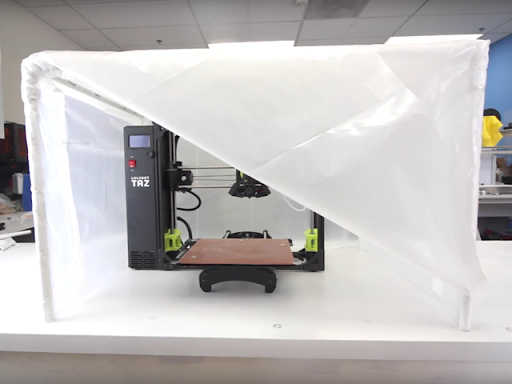Sort of related, see the answers to:
Addressing your points in turn:
- Ventilation - Probably not, as you want to keep the print warm. However, when printing with filaments where well ventilated conditions are recommended1, to prevent the build up of noxious fumes, from ABS for example, you would need (active) filtration, see this answer.
- Filament Placement - I have seen printers fully enclosed, including the filament. However, there is the potential issue, especially if using PLA, that if the temperature inside the enclosure reaches temperatures approaching those of a closed car, on a hot day, then the PLA filament could become damaged/melt, and not roll of the spool correctly. In that case, you could place the reel on to of the enclosure and feed it through a (small) hole in the top. Feeding it through the side, could add additional resistance to it being pulled from the reel, depending upon placement.
- Noise cancellation - Line the enclosure with non-flammable foam, or some other non-flammable noise cancelling lining
- Material - As Mark states in his answer, be extra careful of thermal runaway, as 3D printers run hot, and an enclosed printer, even hotter. Wood is the sort of material you probably want to avoid. Whilst it is cheap, and would probably work fine in most situations, in the case of an emergency (read, fire), then you are merely providing additional combustable material. It would be advisable to stick with an aluminium frame (non-combustable) and glass (non-combustable and insulating).
Additonal Points:
- Electronics - You may want to consider placing the electronics (i.e. controller board) outside the enclosure, as the RAMPS board generally likes to be kept as cool as possible (especially the stepper drivers).
- Display/Control - Along with the electronics, it could be a good idea to also place the LCD display, and conjoint control panel, outside the enclosure, so as to provide ease of access. You don't really want to have to keep removing/opening the enclosure to change a minor setting.
- Access - Do you want a lift-off type enclosure, or have an access door? The latter is certainly more user friendly, or convenient.
- Sturdiness - Do you want a light weight (flimsy?) enclosure, or a heavier, more robust, enclosure?
- Safety - An air-tight fire box could be worth considering.
Note: After having stated that wood is not the best idea, it seems that IKEA tables are sometimes used, by stacking two on top of each other: New IKEA hack lets you create a 3D printer enclosure for cheap


A safer bet is this delta printer enclosure, which is, essentially, a larger delta frame, made from aluminium extrusion and acrylic, enclosing a smaller delta printer:
4 Simple Steps to Build Your Own 3D Printer Enclosure

For an example of a cheap, yet extremely flammable enclosure, made from plastic sheeting and piping, see How to build an enclosure for your 3D printer

1 See Davo's comment.



